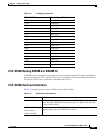
2-29
Cisco ONS 15454 Reference Manual, R7.0
78-17191-01
Chapter 2 Common Control Cards
2.7 2.7.2 External Alarms and Controls
2.7.2 External Alarms and Controls
The AIC-I card provides input/output alarm contact closures. You can define up to twelve external alarm
inputs and 4 external alarm inputs/outputs (user configurable). The physical connections are made using
the backplane wire-wrap pins. See the “1.12 Alarm Expansion Panel” section on page 1-55 for
information about increasing the number of input/output contacts.
LEDs on the front panel of the AIC-I indicate the status of the alarm lines, one LED representing all of
the inputs and one LED representing all of the outputs. External alarms (input contacts) are typically
used for external sensors such as open doors, temperature sensors, flood sensors, and other
environmental conditions. External controls (output contacts) are typically used to drive visual or
audible devices such as bells and lights, but they can control other devices such as generators, heaters,
and fans.
You can program each of the twelve input alarm contacts separately. You can program each of the sixteen
input alarm contacts separately. Choices include:
• Alarm on Closure or Alarm on Open
• Alarm severity of any level (Critical, Major, Minor, Not Alarmed, Not Reported)
• Service Affecting or Non-Service Affecting alarm-service level
• 63-character alarm description for CTC display in the alarm log. You cannot assign the fan-tray
abbreviation for the alarm; the abbreviation reflects the generic name of the input contacts. The
alarm condition remains raised until the external input stops driving the contact or you unprovision
the alarm input.
You cannot assign the fan-tray abbreviation for the alarm; the abbreviation reflects the generic name of
the input contacts. The alarm condition remains raised until the external input stops driving the contact
or you provision the alarm input.
Green/Red PWR A LED The PWR A LED is green when a supply voltage within a specified range
has been sensed on supply input A. It is red when the input voltage on supply
input A is out of range.
Green/Red PWR B LED The PWR B LED is green when a supply voltage within a specified range has
been sensed on supply input B. It is red when the input voltage on supply
input B is out of range.
Amber INPUT LED The INPUT LED is amber when there is an alarm condition on at least one
of the alarm inputs.
Amber OUTPUT LED The OUTPUT LED is amber when there is an alarm condition on at least one
of the alarm outputs.
Green RING LED The RING LED on the local orderwire (LOW) side is flashing green when a
call is received on the LOW.
Green RING LED The RING LED on the express orderwire (EOW) side is flashing green when
a call is received on the EOW.
Table 2-20 AIC-I Card-Level Indicators (continued)
Card-Level LEDs Description


















